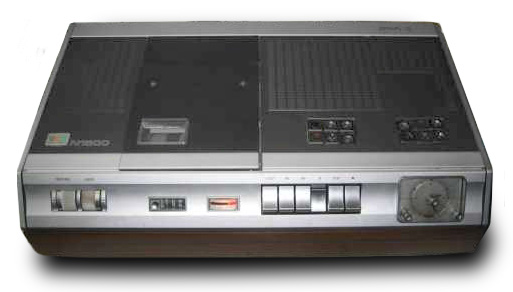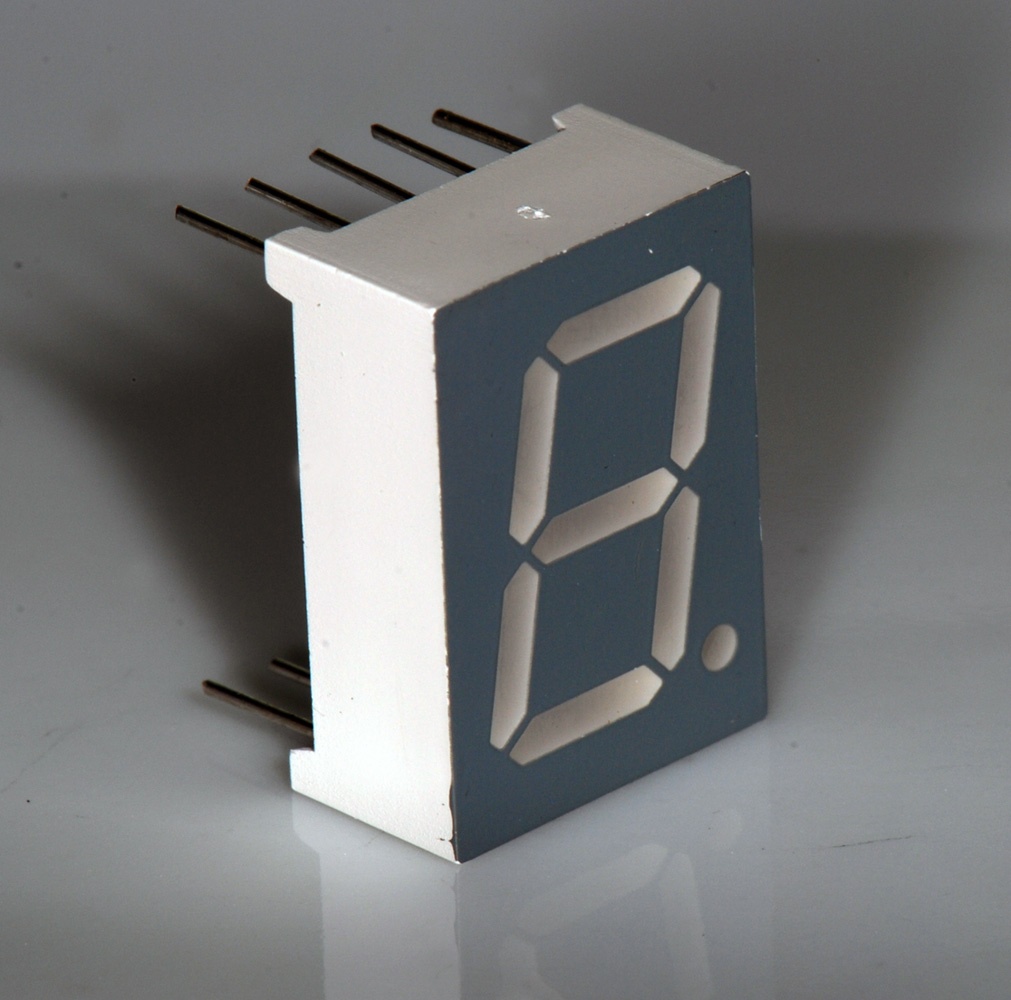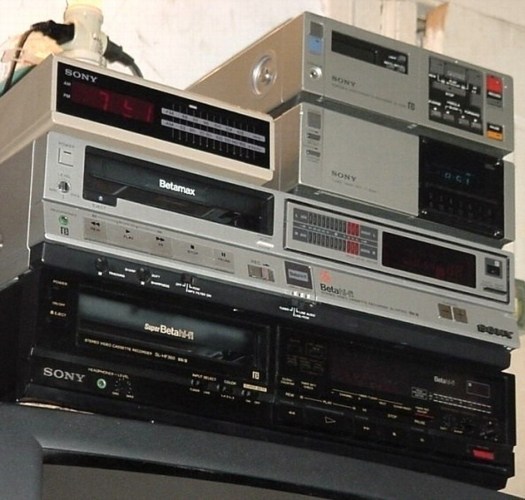|
JVC HR-3300
The JVC HR-3300 VIDSTAR is the world's first VHS-based videocassette recorder, VCR to be released to the market, introduced by the president of JVC at the Okura Hotel on September 9, 1976. Sales started in Japan under the name Victor HR-3300 on 31 October 1976. Foreign sales followed in 1977 with the HR-3300U in the United States, and HR-3300EK in the United Kingdom. In 2008, the HR-3300 became the first VCR to be registered with the National Museum of Nature and Science, based in Tokyo, Japan. It was noted as one of the 85 most disruptive ideas by Business Week in 2014. History Prior efforts The first video recording system sold directly to home users was the 1963 -inch open reel Telcan from the UK, but this was not a commercial success. Sony's CV-2000 was a complete system based on commercial -inch tape on open reels, requiring the user to thread the tape around the helical scan heads. In order to conserve tape, the system recorded every other Video field, field of the televis ... [...More Info...] [...Related Items...] OR: [Wikipedia] [Google] [Baidu] |
Video Cassette Recording
Video Cassette Recording (VCR) is an early domestic analog recording format designed by Philips. It was the first successful consumer-level home videocassette recorder (VCR) system. Later variants included the VCR-LP and Super Video (SVR) formats. The VCR format was introduced in 1972, just after the Sony U-matic format in 1971. Although at first glance the two might appear to have been competing formats, they were aimed at very different markets. After failing as a consumer format, U-matic was marketed as a professional television production format, whilst VCR was targeted particularly at educational but also domestic users. Unlike some other early formats such as Cartrivision, the VCR format does record a high-quality video signal without resorting to Skip field. Home video systems had previously been available, but they were open-reel systems (such as the Sony CV-2000) and were expensive to both buy and operate. They were also unreliable and often only recorded in black an ... [...More Info...] [...Related Items...] OR: [Wikipedia] [Google] [Baidu] |
Zenith Electronics
Zenith Electronics, LLC, is an American research and development company that develops ATSC and digital rights management technologies. It is owned by the South Korean company LG Electronics. Zenith was previously an American brand of consumer electronics, a manufacturer of radio and television receivers and other consumer electronics, and was headquartered in Glenview, Illinois. After a series of layoffs, the consolidated headquarters moved to Lincolnshire, Illinois. For many years, their famous slogan was "The quality goes in before the name goes on". LG Electronics acquired a controlling share of Zenith in 1995; Zenith became a wholly owned subsidiary in 1999. Zenith was the inventor of subscription television and the modern remote control, and was the first to develop high-definition television (HDTV) in North America. Zenith-branded products were sold in North America, Germany, Thailand (to 1983), Cambodia, Laos, Vietnam, India, and Myanmar. History The company was c ... [...More Info...] [...Related Items...] OR: [Wikipedia] [Google] [Baidu] |
Open Standard
An open standard is a standard that is openly accessible and usable by anyone. It is also a prerequisite to use open license, non-discrimination and extensibility. Typically, anybody can participate in the development. There is no single definition, and interpretations vary with usage. The terms ''open'' and ''standard'' have a wide range of meanings associated with their usage. There are a number of definitions of open standards which emphasize different aspects of openness, including the openness of the resulting specification, the openness of the drafting process, and the ownership of rights in the standard. The term "standard" is sometimes restricted to technologies approved by formalized committees that are open to participation by all interested parties and operate on a consensus basis. The definitions of the term ''open standard'' used by academics, the European Union, and some of its member governments or parliaments such as Denmark, France, and Spain preclude open standar ... [...More Info...] [...Related Items...] OR: [Wikipedia] [Google] [Baidu] |
Seven-segment Display
A seven-segment display is a form of electronic display device for displaying decimal numerals that is an alternative to the more complex dot matrix displays. Seven-segment displays are widely used in digital clocks, electronic meters, basic calculators, and other electronic devices that display numerical information. History Seven-segment representation of figures can be found in patents as early as 1903 (in ), when Carl Kinsley invented a method of telegraphically transmitting letters and numbers and having them printed on tape in a segmented format. In 1908, F. W. Wood invented an 8-segment display, which displayed the number 4 using a diagonal bar (). In 1910, a seven-segment display illuminated by incandescent bulbs was used on a power-plant boiler room signal panel. They were also used to show the dialed telephone number to operators during the transition from manual to automatic telephone dialing. They did not achieve widespread use until the advent of LEDs in the 19 ... [...More Info...] [...Related Items...] OR: [Wikipedia] [Google] [Baidu] |
RCA Jack
The RCA connector is a type of electrical connector commonly used to carry audio and video signals. The name ''RCA'' derives from the company Radio Corporation of America, which introduced the design in the 1930s. The connectors male plug and female jack are called RCA plug and RCA jack. It is also called RCA phono connector or phono connector. The word ''phono'' in ''phono connector'' is an abbreviation of the word '' phonograph'', because this connector was originally created to allow the connection of a phonograph turntable to a radio receiver. RCA jacks are often used in phono inputs, a set of input jacks usually located on the rear panel of a preamp, mixer or amplifier, especially on early radio sets, to which a phonograph or turntable is attached. History By no later than 1937, RCA introduced this design as an internal connector in their radio- phonograph floor consoles. The amplifier chassis had female connectors which accepted male cables from the radio chassis ... [...More Info...] [...Related Items...] OR: [Wikipedia] [Google] [Baidu] |
Composite Video
Composite video is an analog video signal format that carries standard-definition video (typically at 525 lines or 625 lines) as a single channel. Video information is encoded on one channel, unlike the higher-quality S-Video (two channels) and the even higher-quality component video (three or more channels). In all of these video formats, audio is carried on a separate connection. Composite video is also known by the initials CVBS for composite video baseband signal or color, video, blanking and sync, or is simply referred to as ''SD video'' for the standard-definition television signal it conveys. There are three dominant variants of composite video signals, corresponding to the analog color system used: NTSC, PAL, and SECAM. Usually composite video is carried by a yellow RCA connector, but other connections are used in professional settings. Signal components A composite video signal combines, on one wire, the video information required to recreate a color pict ... [...More Info...] [...Related Items...] OR: [Wikipedia] [Google] [Baidu] |
VX (videocassette Format)
VX was a consumer analog recording videocassette format developed by Matsushita launched in 1975 in Japan which was short-lived and unsuccessful. In the United States, it was sold using the Quasar brand and marketed under the name "The Great Time Machine" to exhibit its time-shifting capabilities, since VX machines had a companion electro-mechanical clock timer for timed recording of television programs. In Japan, the VX-100 model was launched in 1975, with the VX-2000 following in 1976. The first and only model sold in North America was the Quasar VR-1000 (based on the Panasonic VX-2000), with the VT-100 timer. Design The VX cassette itself had both reels of magnetic tape stacked on top of each other in a coaxial fashion (much like the earlier Cartrivision and Philips VCR formats) in the bottom half of the tape, with a circular opening on the underside of the top half of the cassette, where the video head drum would enter. The tape in this opening was pre-formed in a loop to g ... [...More Info...] [...Related Items...] OR: [Wikipedia] [Google] [Baidu] |
Panasonic
formerly between 1935 and 2008 and the first incarnation of between 2008 and 2022, is a major Japanese multinational conglomerate corporation, headquartered in Kadoma, Osaka. It was founded by Kōnosuke Matsushita in 1918 as a lightbulb socket manufacturer. In addition to consumer electronics, of which it was the world's largest maker in the late 20th century, Panasonic offers a wide range of products and services, including rechargeable batteries, automotive and avionic systems, industrial systems, as well as home renovation and construction. Panasonic has a primary listing on the Tokyo Stock Exchange and is a constituent of the Nikkei 225 and TOPIX 100 indices. It has a secondary listing on the Nagoya Stock Exchange. Corporate name From 1935 to October 1, 2008, the company's corporate name was "Matsushita Electric Industrial Co." (MEI). On January 10, 2008, the company announced that it would change its name to "Panasonic Corporation", in effect on October 1, 2008, ... [...More Info...] [...Related Items...] OR: [Wikipedia] [Google] [Baidu] |
Betamax
Betamax (also known as Beta, as in its logo) is a consumer-level analog recording and cassette format of magnetic tape for video, commonly known as a video cassette recorder. It was developed by Sony and was released in Japan on May 10, 1975, followed by the US in November of the same year. Betamax is widely considered to be obsolete, having lost the videotape format war which saw its closest rival, VHS, dominate most markets. Despite this, Betamax recorders continued to be manufactured and sold until August 2002, when Sony announced that they were discontinuing production of all remaining Betamax models. Sony continued to sell Betamax cassettes until March 2016. Original version Launch and early models The first Betamax device introduced in the United States was the LV-1901 console, which included a color monitor, and appeared in stores in early November 1975. The cassettes contain videotape in a design similar to that of the earlier, professional , U-matic format. ... [...More Info...] [...Related Items...] OR: [Wikipedia] [Google] [Baidu] |
V-Cord
V-Cord is an analog recording videocassette format developed and released by Sanyo. V-Cord (later referred to as V-Cord I) was released in 1974, and could record 60 minutes on a cassette. V-Cord II, released in 1976, could record 120 minutes on a V-Cord II cassette. The V-Cord II machines were the first consumer VCRs to offer two recording speeds. Appearance The original V-Cord cassette had a large hub and was wound with standard-thickness magnetic tape; V-Cord II used a small hub wound with thin tape, the same thickness later used for VHS-120 and Beta L-750. The cassettes were not rectangular, being tapered at one narrow end. Unlike subsequent formats VHS and Betamax, which loaded with the tape facing front on the long side of the cassette, the V-Cord cartridge was loaded sideways with the narrow side serving as the "front" and the tape coming out the "side". The tape was held in place in the machine by a notch halfway down the right side of the tape, similar to the means b ... [...More Info...] [...Related Items...] OR: [Wikipedia] [Google] [Baidu] |






.jpg)
